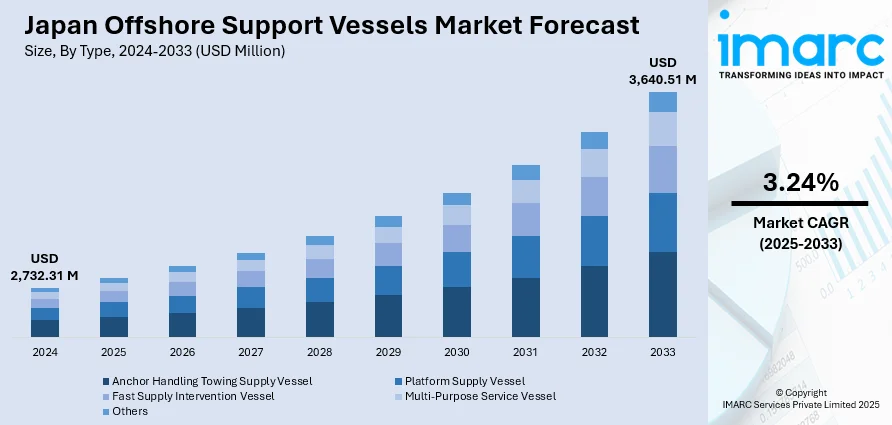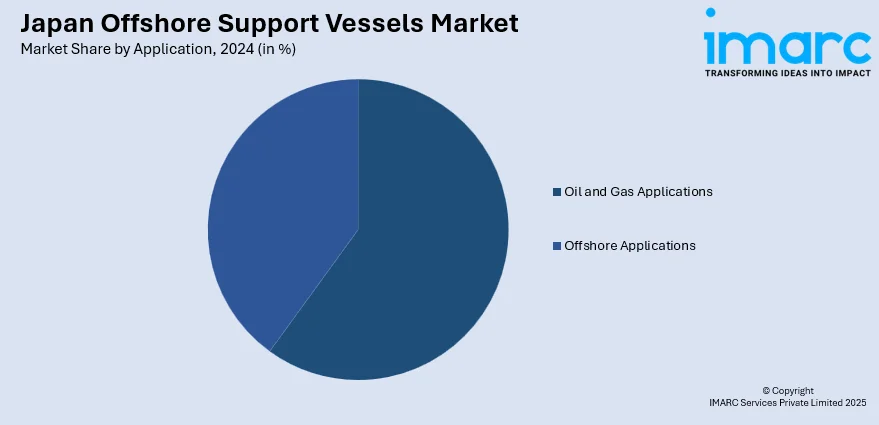
Japan Offshore Support Vessels Market Size, Share, Trends and Forecast by Type, Water Depth, Fuel, Service Type, Application, and Region, 2025-2033
Japan Offshore Support Vessels Market Overview:
The Japan offshore support vessels market size reached USD 2,732.31 Million in 2024. Looking forward, IMARC Group expects the market to reach USD 3,640.51 Million by 2033, exhibiting a growth rate (CAGR) of 3.24% during 2025-2033. The market is being driven by increased investments in offshore wind and oil and gas projects, advancements in vessel technology, rising demand for renewable energy, the aging offshore infrastructure, and supportive government policies and regional energy initiatives.
|
Report Attribute
|
Key Statistics
|
|---|---|
|
Base Year
|
2024 |
|
Forecast Years
|
2025-2033
|
|
Historical Years
|
2019-2024
|
| Market Size in 2024 | USD 2,732.31 Million |
| Market Forecast in 2033 | USD 3,640.51 Million |
| Market Growth Rate 2025-2033 | 3.24% |
Japan Offshore Support Vessels Market Trends:
Surge in Offshore Wind Energy Development
Japan's offshore support vessels (OSV) market is experiencing robust expansion, spurred by the country’s ambitious offshore wind energy expansion. As part of its commitment to achieving net-zero carbon emissions by 2050, Japan is prioritizing offshore wind power as a key renewable energy source, setting a target of generating 30-45 GW from offshore wind by 2040. The rapid expansion of offshore wind projects is driving a rising need for OSVs, which play a crucial role in the installation, maintenance, and logistics of wind farms. Vessels like Crew Transfer Vessels (CTVs) and Platform Supply Vessels (PSVs) are vital for ferrying personnel, equipment, and supplies to and from distant offshore wind sites. With global players like Ørsted contributing to large-scale projects along Japan’s coastlines and government initiatives like the Feed-in Tariff (FiT) program further incentivizing offshore wind developments, the demand for OSVs is expected to grow substantially, making the offshore wind sector a cornerstone of Japan’s energy strategy.

Technological Advancements and Vessel Upgrades
Japan's OSV market is also being propelled by technological advancements aimed at improving vessel design and operational efficiency. As Japan’s offshore energy industry, encompassing oil, gas, and renewable sources, continues to expand, the demand for more advanced and environmentally sustainable vessels is increasing. The integration of hybrid propulsion systems has cut fuel consumption compared to conventional vessels, supporting Japan’s goals of decarbonization and sustainability. Additionally, the integration of autonomous systems, advanced navigation, and remote monitoring technologies enhances operational efficiency, safety, and reduces human error. These innovations are particularly important as offshore operations expand into more complex, far-offshore locations. These technological advancements are forecasted to reduce operating costs, driving further demand for modern, eco-friendly vessels.
Japan Offshore Support Vessels Market Segmentation:
IMARC Group provides an analysis of the key trends in each segment of the market, along with forecasts at the region/country level for 2025-2033. Our report has categorized the market based on type, water depth, fuel, service type, and application.
Type Insights:
- Anchor Handling Towing Supply Vessel
- Platform Supply Vessel
- Fast Supply Intervention Vessel
- Multi-Purpose Service Vessel
- Others
The report has provided a detailed breakup and analysis of the market based on the type. This includes anchor handling towing supply vessel, platform supply vessel, fast supply intervention vessel, multi-purpose service vessel, and others.
Water Depth Insights:
- Shallow Water
- Deepwater
A detailed breakup and analysis of the market based on the water depth have also been provided in the report. This includes shallow water and deepwater.
Fuel Insights:
- Fuel Oil
- LNG
The report has provided a detailed breakup and analysis of the market based on the fuel. This includes fuel oil and LNG.
Service Type Insights:
- Technical Services
- Inspection and Survey
- Crew Management
- Logistics and Cargo Management
- Anchor Handling and Seismic Support
- Others
A detailed breakup and analysis of the market based on the service type have also been provided in the report. This includes technical services, inspection and survey, crew management, logistics and cargo management, anchor handling and seismic support, and others.
Application Insights:

- Oil and Gas Applications
- Offshore Applications
The report has provided a detailed breakup and analysis of the market based on the application. This includes oil and gas applications and offshore applications.
Regional Insights:
- Kanto Region
- Kansai/Kinki Region
- Central/Chubu Region
- Kyushu-Okinawa Region
- Tohoku Region
- Chugoku Region
- Hokkaido Region
- Shikoku Region
The report has also provided a comprehensive analysis of all the major regional markets, which include Kanto Region, Kansai/Kinki Region, Central/Chubu Region, Kyushu-Okinawa Region, Tohoku Region, Chugoku Region, Hokkaido Region, and Shikoku Region.
Competitive Landscape:
The market research report has also provided a comprehensive analysis of the competitive landscape. Competitive analysis such as market structure, key player positioning, top winning strategies, competitive dashboard, and company evaluation quadrant has been covered in the report. Also, detailed profiles of all major companies have been provided.
Japan Offshore Support Vessels Market News:
- April 2025: Japan's Ministry of Defense commenced the construction of the first four of twelve planned offshore patrol vessels (OPVs). These vessels are intended to enhance Japan's maritime security capabilities.
- January 2024: NYK partnered with Kosaba Shipbuilding Corporation to procure a crew transfer vessel (CTV), marking its first such order from a Japanese shipyard. Scheduled for delivery in late 2025 or 2026, the vessel will transport technicians for the construction and maintenance of offshore wind facilities off Japan's coast.
Japan Offshore Support Vessels Market Report Coverage:
| Report Features | Details |
|---|---|
| Base Year of the Analysis | 2024 |
| Historical Period | 2019-2024 |
| Forecast Period | 2025-2033 |
| Units | Million USD |
| Scope of the Report |
Exploration of Historical Trends and Market Outlook, Industry Catalysts and Challenges, Segment-Wise Historical and Future Market Assessment:
|
| Types Covered | Anchor Handling Towing Supply Vessel, Platform Supply Vessel, Fast Supply Intervention Vessel, Multi-Purpose Service Vessel, Others |
| Water Depths Covered | Shallow Water, Deepwater |
| Fuels Covered | Fuel Oil, LNG |
| Service Types Covered | Technical Services, Inspection and Survey, Crew Management, Logistics and Cargo Management, Anchor Handling and Seismic Support, Others |
| Applications Covered | Oil and Gas Applications, Offshore Applications |
| Regions Covered | Kanto Region, Kansai/Kinki Region, Central/Chubu Region, Kyushu-Okinawa Region, Tohoku Region, Chugoku Region, Hokkaido Region, Shikoku Region |
| Customization Scope | 10% Free Customization |
| Post-Sale Analyst Support | 10-12 Weeks |
| Delivery Format | PDF and Excel through Email (We can also provide the editable version of the report in PPT/Word format on special request) |
Key Questions Answered in This Report:
- How has the Japan offshore support vessels market performed so far and how will it perform in the coming years?
- What is the breakup of the Japan offshore support vessels market on the basis of type?
- What is the breakup of the Japan offshore support vessels market on the basis of water depth?
- What is the breakup of the Japan offshore support vessels market on the basis of fuel?
- What is the breakup of the Japan offshore support vessels market on the basis of service type?
- What is the breakup of the Japan offshore support vessels market on the basis of application?
- What are the various stages in the value chain of the Japan offshore support vessels market?
- What are the key driving factors and challenges in the Japan offshore support vessels market?
- What is the structure of the Japan offshore support vessels market and who are the key players?
- What is the degree of competition in the Japan offshore support vessels market?
Key Benefits for Stakeholders:
- IMARC’s industry report offers a comprehensive quantitative analysis of various market segments, historical and current market trends, market forecasts, and dynamics of the Japan offshore support vessels market from 2019-2033.
- The research report provides the latest information on the market drivers, challenges, and opportunities in the Japan offshore support vessels market.
- Porter's five forces analysis assist stakeholders in assessing the impact of new entrants, competitive rivalry, supplier power, buyer power, and the threat of substitution. It helps stakeholders to analyze the level of competition within the Japan offshore support vessels industry and its attractiveness.
- Competitive landscape allows stakeholders to understand their competitive environment and provides an insight into the current positions of key players in the market.
Need more help?
- Speak to our experienced analysts for insights on the current market scenarios.
- Include additional segments and countries to customize the report as per your requirement.
- Gain an unparalleled competitive advantage in your domain by understanding how to utilize the report and positively impacting your operations and revenue.
- For further assistance, please connect with our analysts.
 Request Customization
Request Customization
 Speak to an Analyst
Speak to an Analyst
 Request Brochure
Request Brochure
 Inquire Before Buying
Inquire Before Buying




.webp)




.webp)












